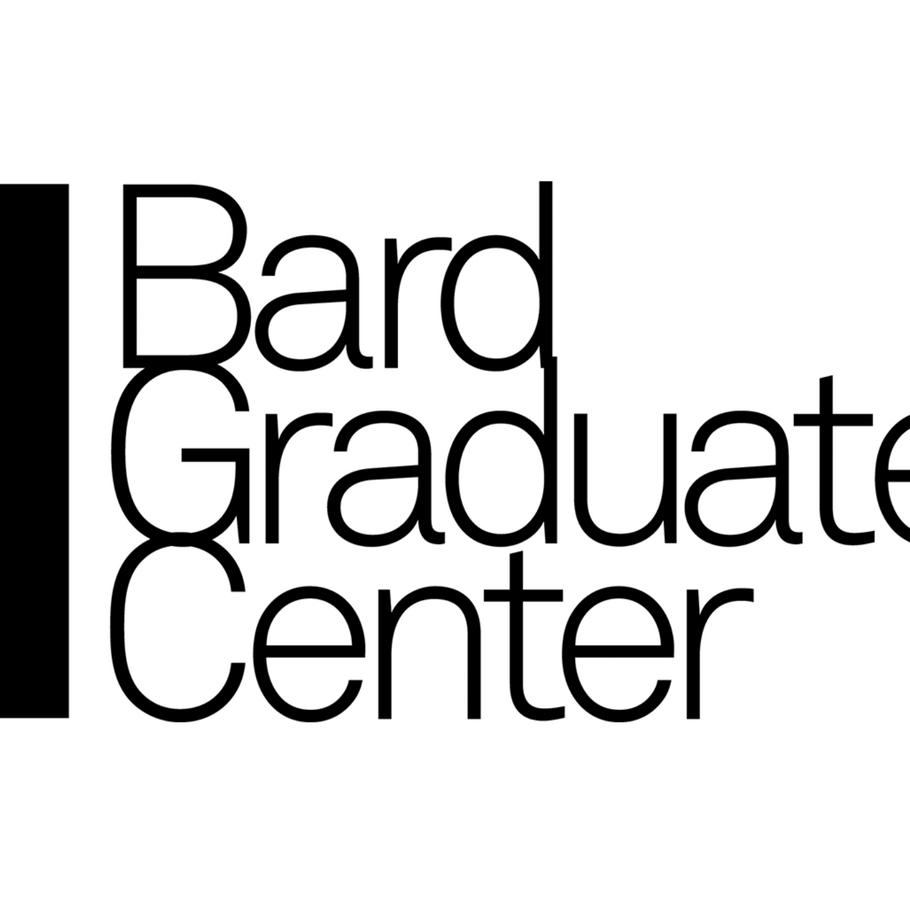
At a Glance
Ages: All
Allows Food/Drink: No
Luggage Storage: No
18 W 86th St, New York, NY 10024 Get Directions
Bard Graduate Center Gallery Videos
Glassblowing as Terraforming: Posthumanist Turns in Theories of Embodied Knowledge A Paul and Irene Hollister Lecture on Glass by Erin E. O’Connor (Marymount Manhattan College) “The first silica mine that I visited had ‘pulled a shot’ that morning; they had dynamited a portion of the mountain, reducing half of the ridge before me to ten tons of rubble. The silica was largely destined for glassmaking factories serving the architecture and automotive industries. Yet, some silica would be shipped to glassmakers serving the contemporary Studio Glass art world.” —Erin E. O’Connor In the mid-twentieth century, American artists turned to glass as a medium of expression, distinguishing themselves from factory glassworkers. Left out of this history—which is rich with artist biographies and aesthetic analyses of glass objects—is the material life of silica mines. In this lecture, Erin E. O’Connor connects the formation of glass objects to the ongoing formation of the earth, seeing them as two sides of one artistic process. Drawing from anthropological fieldwork at mines and a glassmaking facility in Appalachia to explore these intertwined yet unconnected realms, she aims to overcome a deep-seated dualism between human creativity and natural science that polarizes glassmaking (mixing ingredients) and glassblowing (making objects). In doing so, she addresses how the human experience of self-determination and creativity intersects with the living (and dying) ecological world. A conversation with BGC MA RJ Maupin will follow the lecture. Erin E. O’Connor is an associate professor of sociology and affiliate faculty of environmental studies at Marymount Manhattan College. She also contributes to the college’s BFA in art. She is a 2023 recipient of the Rakow Grant for Glass Research at the Corning Museum of Glass and the author of Fire-Craft: Art, Body, and World Among Glassblowers (In Contract, Columbia University Press). A world-recognized expert in craft studies, she offers a symgeologic account of American studio glassblowing from the vantage of mines and minerals in her current book project, The Middle Mineral & the Mine: An Ethnomineraology of Studio Glassblowing.
Constantinopoliad: An interactive installation by Sister Sylvester and Nadah El Shazly In this interactive installation by Sister Sylvester and Nadah El Shazly, audiences read together from handmade books, enveloped in El Shazly’s live score. The work is inspired by the blank and torn out pages of a journal (that the teenaged C. P. Cavafy began when he and his family fled Alexandria); by lost and missing archives through time; and by the ghosts, both erotic and historical, that visit the older Cavafy in his poems. • • Sister Sylvester is a new media artist based in New York and Istanbul. She is a current resident at ONX Studio; a 2019 MacDowell Fellow; an alumnus of the Public Theater New Works program and the CPH:DOX lab. Her most recent film, Our Ark, codirected with Deniz Tortum, explores the relationship between computational thinking and the climate crisis. It premiered at IDFA (International Documentary Film Festival) ’21 and has screened at international festivals, winning Best Short Film at the Istanbul International Film Festival. With efrin nowar she creates books that become performances, spatial narratives that play with spoken and written text to create communal reading experiences. She is currently developing a series of work that uses low-tech means to explore the stakes of new technologies, including synthetic biology and VR. She teaches a bio-art class, “The School of Genetically Modified Theater,” at Colorado College, and has also taught and lectured at Massachusetts Institute of Technology; Princeton University; University of Colorado, Colorado Springs; Columbia University; and Bogazici Istanbul. Since the release of her debut album, Ahwar, the composer and vocalist Nadah El Shazly has become a pillar of the Egyptian underground. In 2018, she appeared on the cover of the British experimental-music magazine The Wire in an issue announcing “Cairo’s New Wave.” The musician’s eclectic background, encompassing choirs, punk rock, and electronic music, prepared her for the electroacoustic reimagining of Arabic classical music that is inherent to Ahwar, exploring new sonic and harmonic frontiers. Backing up her release with extensive worldwide touring, El Shazly has been featured in many local and international festivals. She is currently working on her second album and continues to compose for film and moving image.
Scrolls as Material Artifacts The Leon Levy Foundation Lectures in Jewish Material Culture Jonathan Ben-Dov Encounters of Text and Material Culture in Ancient Judea is a three-evening lecture series that engages with Judean and later Jewish material culture during the first millennium BCE, mostly at the latter third of this millennium during the Hellenistic-Roman period. This is not an archeological study surveying pottery assemblages and architectural plans. Instead, Jonathan Ben-Dov focuses on particular types of material objects that lend themselves to interaction with texts. The surveyed materials are widely variegated: from monumental rock reliefs that straddle the borders of nature and culture to handheld devices for time measurement. Special attention is dedicated to scrolls, which posit the text-and-matter encounter in a particularly poignant way, and where new paths are trodden today, in the digital age.
The Material of Apocalypses: Rock Reliefs and the Literary Imagination Encounters of Text and Material Culture in Ancient Judea The Leon Levy Foundation Lectures in Jewish Material Culture Jonathan Ben-Dov Encounters of Text and Material Culture in Ancient Judea is a three-evening lecture series that engages with Judean and later Jewish material culture during the first millennium BCE, mostly at the latter third of this millennium during the Hellenistic-Roman period. This is not an archeological study surveying pottery assemblages and architectural plans. Instead, Jonathan Ben-Dov focuses on particular types of material objects that lend themselves to interaction with texts. The surveyed materials are widely variegated: from monumental rock reliefs that straddle the borders of nature and culture to handheld devices for time measurement. Special attention is dedicated to scrolls, which posit the text-and-matter encounter in a particularly poignant way, and where new paths are trodden today, in the digital age.
Encounters of Text and Material Culture in Ancient Judea: Time Machines in Text and Matter Lecture 1 The Leon Levy Foundation Lectures in Jewish Material Culture Jonathan Ben-Dov Encounters of Text and Material Culture in Ancient Judea is a three-evening lecture series that engages with Judean and later Jewish material culture during the first millennium BCE, mostly at the latter third of this millennium during the Hellenistic-Roman period. This is not an archeological study surveying pottery assemblages and architectural plans. Instead, Jonathan Ben-Dov focuses on particular types of material objects that lend themselves to interaction with texts. The surveyed materials are widely variegated: from monumental rock reliefs that straddle the borders of nature and culture to handheld devices for time measurement. Special attention is dedicated to scrolls, which posit the text-and-matter encounter in a particularly poignant way, and where new paths are trodden today, in the digital age.
Portable Tombs of Memory: The Ringelblum Archive as a Collection of Objects is a three-part lecture series by Bożena Shallcross. It explores the Ringelblum Archive as a collection of material objects that informs our perception of the “bare everyday” during the Jewish genocide, the question of the material durability and fragility of objects, and the methods of preserving their materiality. Buried like coffins, the unassuming metal containers of what is known as the Oneg Shabbat project were filled with veritable treasure: testimonies, diaries, drawings, photographs, tram tickets, and even candy wrappers secretly collected by a group of dedicated individuals in the Warsaw Ghetto. Unearthed after the war, they have been understood as archives of knowledge with a unique significance for the history of the Holocaust, extending the spatial boundaries of the Warsaw Ghetto to the entire occupied Polish territory. The lectures discuss the protective function of the containers, their own vulnerability, as well as their contents, as both ephemeral and textual objects. In the first lecture, The Hidden Treasure, Shallcross discusses the discovery of the archives in the ruins of the Warsaw Ghetto and briefly narrates the concept of the Oneg Shabbat as an archival project according to which every object taken “from within” the extreme conditions of the Ghetto under siege has a historical significance. She analyzes how these material paper objects, hidden inside rusty and ugly containers, revealed an enormous testimonial value and she compares this paradox to the ancient Greek habit of keeping precious objects (agalmata) in unassuming containers.
More in The Upper West Side
More Museums
- The Tenement Museum
- New Museum
- International Center of Photography
- Museum at Eldridge Street
- National Museum of the American Indian
- National September 11 Memorial & Museum
- The Rubin Museum of Art
- Whitney Museum of American Art
- The Morgan Library & Museum
- Museum of Modern Art (MoMA)
Bard Graduate Center Gallery Frequently Asked Questions
The closest subway stops to Bard Graduate Center Gallery at 18 W 86th St are the 86th Street station on the 1 train and the 86th Street station on the B and C trains. Both stations are just a short walk away from the gallery.
If you're planning to take the 1 train, you can check for any service updates or changes on the MTA website [here](https://new.mta.info/). For the B and C trains, you can find the latest information on the MTA website [here](https://new.mta.info/).
While you're in the area, there are a few other attractions you might want to check out. The American Museum of Natural History is just a few blocks away from Bard Graduate Center Gallery, and it's definitely worth a visit. You can find more information about the museum [here](https://www.amnh.org/).
If you're looking for a bite to eat, there are plenty of great options in the Upper West Side. Some popular restaurants in the area include Jacob's Pickles, a Southern comfort food spot known for their delicious biscuits and pickles, and Shake Shack, a beloved burger joint. You can find more dining recommendations in the area [here](https://www.timeout.com/newyork/restaurants/upper-west-side-restaurants).
I hope you have a wonderful time exploring the Upper West Side and enjoying the Bard Graduate Center Gallery!
The closest bus stops to Bard Graduate Center Gallery at 18 W 86th St in New York City are:
1. Central Park West/W 86 St: Served by the M10 bus. You can check for updates on the M10 bus schedule [here](http://bustime.mta.info/m/index?q=400024).
2. Broadway/W 86 St: Served by the M104 bus. You can check for updates on the M104 bus schedule [here](http://bustime.mta.info/m/index?q=400104).
These bus stops are conveniently located near Bard Graduate Center Gallery and provide easy access to the surrounding area. Make sure to check the MTA website for any updates or changes to bus schedules. Enjoy your visit to the gallery!
The ideal length of time to plan to spend at Bard Graduate Center Gallery in New York City would be around 1-2 hours. This will give you enough time to explore the gallery's exhibitions and collections at a leisurely pace, without feeling rushed. The gallery showcases a wide range of art and design objects, so take your time to appreciate the intricate details and immerse yourself in the cultural experience. Additionally, the gallery often hosts special exhibitions and events, so be sure to check their schedule to see if there's anything specific you'd like to attend during your visit.
The Bard Graduate Center Gallery in New York City does not have its own food or drink policy, as it is primarily an academic institution and exhibition space. However, it is always a good idea to check with the specific exhibition or event you plan to attend, as they may have their own policies in place. Additionally, please note that there are plenty of dining options available in the surrounding area of the Bard Graduate Center Gallery, so you can easily grab a bite to eat before or after your visit.
The Bard Graduate Center Gallery in New York City does not offer luggage storage facilities. However, there are several options available nearby where you can securely store your belongings while you explore the gallery or the surrounding area.
One convenient option is to use a luggage storage service such as LuggageHero or Vertoe. These services allow you to drop off your bags at designated locations, typically near major transportation hubs or popular tourist areas. They provide secure storage for your luggage and offer flexible hours for pick-up and drop-off.
Another alternative is to check if your accommodation offers luggage storage facilities. Many hotels and hostels provide this service for their guests, even if you have already checked out. It's worth contacting your accommodation in advance to inquire about their luggage storage options.
Lastly, if you are visiting other attractions or museums in the city, they may have their own luggage storage facilities. It's always a good idea to check their websites or contact them directly to see if they offer this service.
Remember to plan ahead and consider your options to ensure a hassle-free visit to the Bard Graduate Center Gallery and other attractions in New York City.
Yes, Bard Graduate Center Gallery is a great destination for visitors from other countries and non-English language speakers. The gallery showcases a diverse range of exhibitions exploring decorative arts, design history, and material culture from around the world. The exhibits are visually engaging and offer a unique perspective on art and design.
While English is the primary language used in the gallery, there are often multilingual materials available, including brochures and signage, to enhance the visitor experience. Additionally, the gallery staff is friendly and knowledgeable, and they are always ready to assist visitors in multiple languages.
Bard Graduate Center Gallery is conveniently located in the heart of New York City, making it easily accessible for tourists. Whether you're a design enthusiast, an art lover, or simply curious about different cultures, this gallery is a must-visit destination that offers a rich and immersive experience for visitors from all over the world.
The Bard Graduate Center Gallery in New York City is a great destination for visitors of all ages. While there is no specific age range recommended, the gallery offers a diverse range of exhibitions and programs that cater to various interests and levels of understanding. Families with children can enjoy exploring the gallery together, as there are often interactive elements and educational materials available. However, it is worth noting that some exhibitions may contain content that is more suitable for older children and adults. Ultimately, the gallery's engaging displays and thought-provoking exhibits make it a worthwhile visit for individuals of all ages.
Videos



